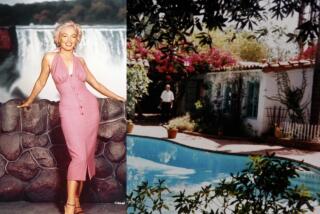Compromise Reached on Schindler House
- Share via
A neighborhood compromise has ended an international dispute about form versus functions that threatened one of Southern California’s most famous houses.
West Hollywood residents and an Austrian group working to preserve the 78-year-old Schindler House have agreed on a plan for the Kings Road architectural landmark to be used for meetings and special events that will help pay for its permanent maintenance.
Those living near the low-slung, concrete-and-wood structure, designed by Austrian-born architect Rudolf Schindler, objected last year to efforts by a Vienna-based arts museum to repair the house, rent it to outside groups for conferences and parties and turn the icon of early modernism into a center for arts and architecture.
They complained that the resulting noise and traffic disrupted the neighborhood. West Hollywood officials weighed in, alleging that the parties and conferences were being staged in the residential area without permission.
But leaders of MAK, an acronym for Osterreichisches Museum fur Angewandt Kunst--the Austrian Museum of Applied Arts--said that an expanded use of the house was necessary for it to survive physically and financially.
City officials turned to a professional dispute mediator last fall in hopes of ending the controversy. To the surprise of all, it worked.
Homeowners in condominium units near the sprawling, U-shaped building acknowledged their own appreciation of the Schindler House. They explained to mediator Joel Hecht of Dispute Resolutions Services that many of them had pitched in to help maintain the house in the past.
MAK representatives conceded that limits could be placed on events without threatening the goal of making the house financially self-sufficient.
Officials from Vienna have worked to refurbish the house since 1994, when they formed a 10-year joint venture with a nonprofit local group called Friends of the Schindler House, which owns the structure. Since then, the Austrian government has pumped about $400,000 a year into repairs and maintenance.
But the Austrians plan to end their support in four years. To guarantee that the house survives financially, they have sought to turn it into a public attraction, a rental venue for various functions and a conference center for design students and professionals.
“What we’re doing is very close to what Schindler himself had in mind,” Peter Noever, executive director of MAK, explained during the height of the controversy four months ago.
The Austrians found the dispute ironic, because the Schindler House was a haven for avant-garde intellectuals in its heyday. They gathered there to experiment with communal living and discuss art and literature after Schindler, who immigrated to Los Angeles, began building it in 1921.
Acclaimed as “the cradle of Southern California’s modern architecture,” the structure has been described as “sweetly decadent” and “built for swingers” who partied with Schindler.
The compromise agreement, signed by residents and MAK officials and filed Wednesday by city planners, limits the number of “high-impact events” at the house to three per month, only one of which can be on a weekend. They are defined as gatherings that attract 200 or more visitors or involve amplified music or outdoor film screenings longer than an hour.
Detailed rules for parking, catering, hours of operation and trash removal were also agreed upon. MAK leaders promised to provide residents with a detailed schedule of Schindler House events so those in the neighborhood could plan around them.
West Hollywood planner Elizabeth Bar-El said the successful mediation was a first for the city.
“This is a good example of what can work where there’s a common purpose,” she said.
More to Read
The biggest entertainment stories
Get our big stories about Hollywood, film, television, music, arts, culture and more right in your inbox as soon as they publish.
You may occasionally receive promotional content from the Los Angeles Times.











